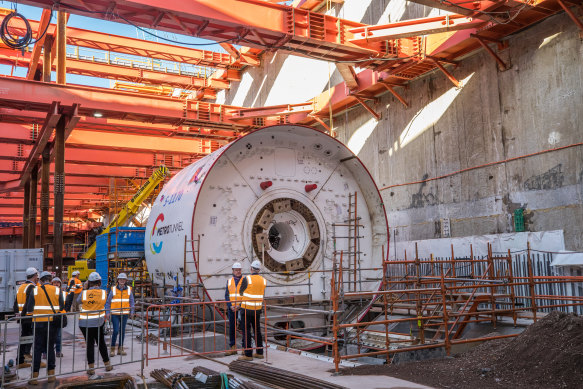Suburbs and marginal seats face spending cuts to rein in inflation
Save articles for later
Add articles to your saved list and come back to them any time.
States will have to accommodate a $33 billion haircut to their suburban road and rail plans plus promised capital works in marginal seats across the country as the federal government attempts to bring under control huge cost overruns on its infrastructure program.
Infrastructure Minister Catherine King on Monday confirmed the government would still sink $120 billion into the 10-year building program, but projects in every state were likely to delayed or axed to claw back the $33 billion in cost blowouts on projects announced by previous governments.
The states have more than $100 billion worth of road and rail projects under way.Credit: Jason South
In May, King announced a 90-day review of the government’s infrastructure pipeline by federal and state bureaucrats Mike Mrdak, Reece Waldock and Clare Gardiner-Barnes amid concerns the cost and number of projects had grown out of control. It has already started trimming projects promised by the previous government, including the $5.4 billion Hells Gate Dam in Far North Queensland.
Last week, the International Monetary Fund urged all governments to slow down and better co-ordinate infrastructure spending, saying it was contributing to inflation pressures that might require even higher interest rates on mortgage holders.
King, who is expected to release the infrastructure review in coming weeks, said the government remained committed to a $120 billion pipeline of projects, with 300 of them under construction.
She said there were likely to be cost overruns above the $33 billion already identified, noting that each project in the pipeline was affected.
“What I don’t want to do is promise people that we’re going to build something when it clearly is not going to be built,” she said.
The review looked at around 200 projects and recommended some should be cancelled and others delayed allowing costs to be fully considered, she added.
But opposition infrastructure spokeswoman Bridget McKenzie described the claim that spending should be reduced to deal with inflation pressures as “complete misinformation”.
“They are leaning on the infrastructure build at the same time they are bringing in over 500,000 new arrivals into our already congested cities and suburbs,” she said.
“The prime minister needs to guarantee that projects to assist with the congestion in our crowded cities and suburbs will not be cut.”
The states have more than $100 billion worth of road and rail projects under way, with projects worth hundreds of billions of dollars more either committed or under consideration.
The government is holding talks with every state and territory government about the infrastructure review and what it will mean for their jointly funded projects.
While big-ticket items already under construction are expected to be spared delays or cuts, states increasingly believe hundreds of smaller-valued projects, or ones for which no proper cost-benefit analysis was carried out before they were promised, are in the federal government’s sights.
Marion Terrill, transport and cities director with the Grattan Institute, said all governments had embarked on major infrastructure programs that were now being squeezed by cost blowouts and inflation.
She said some major projects that were already well over budget would be difficult to axe, but there were some that could be modified or delayed reducing financial pressure.
One of the worst offenders was the federally funded 1700-kilometre Inland Rail freight link between Brisbane and Melbourne, which was estimated to cost $4.4 billion when announced in 2010. A report commissioned by King revealed earlier this year it was now likely to cost at least $31 billion, with no decision on the terminals for the link.
“It’s an absolute money pit,” Terrill said.
Australian Automobile Association managing director Michael Bradley said motorists would be unlikely to welcome cuts to transport funding given the 20 per cent lift in the national road toll this year and with fuel excise about to exceed 50 cents a litre.
“The Labor government came to power promising to ‘end the rorts’ in road funding, by extracting better road quality and road safety data from states,” he said.
“This was a good commitment, but it still has to happen if the government wants to save lives, end pork-barrelling, or justify which projects end up on the cutting-room floor.”
Cut through the noise of federal politics with news, views and expert analysis. Subscribers can sign up to our weekly Inside Politics newsletter.
Most Viewed in Politics
From our partners
Source: Read Full Article
